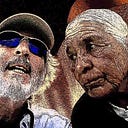The Zone of Interest
“To think in the million years plus that humans have been evolving, in my lifetime, I might hear the last nightingale — that’s incomprehensible.” British folk singer Sam Lee in the film The Nightingale’s Song
The term “zone of interest” can have different meanings depending on the context.
For example, in photography, the zone of interest refers to the area in a photograph that the photographer wants to draw attention to, usually through composition, focus, or lighting.
Our shared zone of interest
right now is right here.
We know nothing
of what’s happening
one block over.
In movies that’s called
off-screen space.
The nightengale lives there in that space.
The homeless live there in that space.
The mentally ill live there in that space.
The innocent victims of war live there in that space.
Nuclear war is again a real threat.
Reality marches on whether we take notice or not.
Impartially speaking,
you and I are living through
a shitshow
of an historical moment.
Perhaps it’s time we take notice.
Perhaps it’s time we expand our zone of interest.
The voices of nightingales have lit up the forests of England at night every spring for thousands of years, inspiring generations of writers, artists, and musicians. But as climate change and development harm their habitats, nightingales may disappear from the country within the next fifty years. What would be forgotten if we no longer heard the call of this beloved bird? In The Nightingale’s Song, we meet Sam Lee, a folk singer who draws on an ancient lineage of traditional folk music as he joins this elusive bird in spontaneous song. Through his practice of devotion to the nightingale, Sam opens a pathway into a deepening relationship of care, stewardship, and love with these songbirds and the living world we share.
